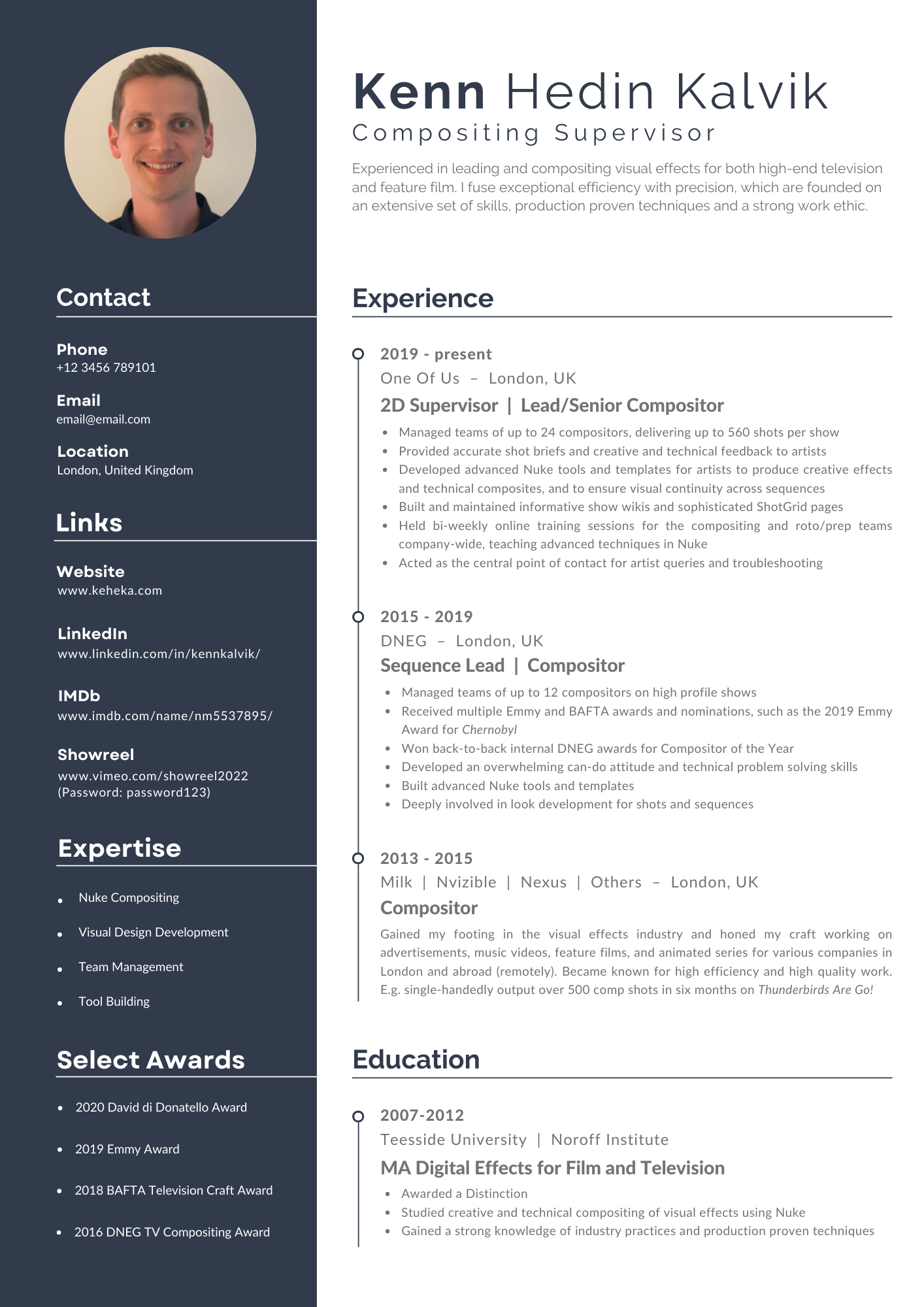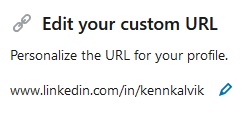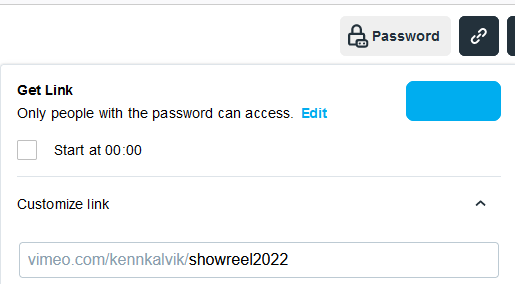How To Get Hired As A Compositor – Part 4: Write An Impressive CV
In this 8-part guide, I will take you through best practices for every step of the journey to getting hired as a compositor. ➜ Part 4 is about how to design and write a CV that will impress any VFX recruiter…

In this 8-part guide, I will take you through best practices for every step of the journey to getting hired as a compositor. ➜ Part 4 is about how to design and write a CV that will impress any VFX recruiter.
You can find the previous parts of the guide here:
Part 2: Build A Strong Network
Part 3: Create A Spectacular Showreel
Why You Should Level Up Your CV
Today, recruiters will typically look you up on LinkedIn, however there is still value in making a sleek, curated CV to show off the best version of yourself. Especially for when you are the first person to reach out.

Example: My own CV (with certain information changed for privacy/confidentiality).
Design
While the content of your CV is the most important part, how you present it to the recruiter is a very close second. Just a single, hard to read block of text with no punctuation will give a bad first impression.
You don't need to hire a professional to design your CV. Though, spending a bit of time to create a sleek and modern looking document is absolutely worth it.
I recommend creating a free account at Canva (not sponsored, and I genuinely use this myself), and using one of their professional templates for designing your CV. There are many great options to choose from – just search for 'Professional CV'.
Keep your CV to 1 page. I have worked a decade in the visual effects industry, and if I can fit my experience on one page, so can you.
Above all, your CV should be easy to read. Present the information in your CV concisely, and avoid large walls of text. Make sure to leave space to breathe throughout.
Make clear, distinct sections in your CV for the various information. Separate them using lines if needed. It will help to give the reader’s eyes a break in between segments. Your CV should be easily scannable so they can find the information they need right away, and easily skimmable so they can get a good idea of how eligible you are as a candidate quickly.
Make use of bullet points. They are a great way of presenting information
Clearly
Succinctly
Use a clean font. Personally, I use Raleway but there are tons of great options. I would go with a modern, sans serif, font. Avoid dated or silly looking fonts such as Times New Roman or Comic Sans.
Content
Regardless of how you design your CV, there is certain information that you should include.
Name, Title & Description
At the top of your CV, put your full name in large letters. Don't write Curriculum Vitae or CV. That is self-evident and redundant.
I like to put my picture next to my name but this is optional. If you do use a picture, pick a nice, simple headshot of yourself with a clean background. Smiling is very welcomed and gives off positive vibes and a good first impression.
Under your name, put your title. This should be short and sweet, like Compositor, Lead Compositor, Compositing Supervisor, etc. Unless you are clearly a senior or above, I wouldn’t put your level in there. That is up to the company you’re applying for to decide. If you have one year of experience as a compositor and write “Mid-level Compositor”, that just shows lack of self-judgement. You don’t want a recruiter to stop and second-guess anything on your CV.
Next, add a short description of yourself and why you are great at this role. This should only be 1-3 sentences. Highlight some of your top qualities.
As an example, mine says:
Experienced in leading and compositing visual effects for both high-end television and feature film. I fuse exceptional efficiency with precision, which are founded on an extensive set of skills, production proven techniques and a strong work ethic.
With all of the above, the recruiter will have an initial idea of who you are and what role you are applying for after just the first few seconds of looking at your CV.
Contact Information
Moving on, add a contact information section where you put your phone number (include the country code if relevant), your email address, and the city you live in. You don't need to write your full address. If and when you get hired, you'll share that information.
Links
Next up, add links to your:
Website: This should be your professional portfolio and/or industry related website. If you have a website for a hobby such as photography or a skill related to compositing, that’s also a good idea to include.
Showreel: This will typically be a password protected Vimeo link – remember to include the password!
IMDb page: Many of you will have an IMDb page. Make sure to keep it up to date and add credits for shows that you have worked on – if and when you are allowed to. It’s a good reference for recruiters to look at and get an idea of both the type and standard of projects you have been involved in. Here is how to add credits on IMDb.
LinkedIn profile: Keep your LinkedIn profile up to date just like your CV. Your LinkedIn profile is also an opportunity to flesh out the details of your career, skills, awards, etc. as it doesn't need to be compressed down to a single page. Keep it concise and digestible, still. It should have bullet points and white space similar to your CV.
Write the links out in full, just in case the recruiter needs to copy or type them elsewhere, or in the event the CV is printed out. So, write www.linkedin.com/in/kennkalvik instead of LinkedIn Profile. The latter one printed out won’t do much good.
Make sure that any links that you include are functioning properly. Test them, and double check that they work correctly.
Custom URLs
You can make a custom URL for your LinkedIn profile by going to your LinkedIn profile page, and in the top right hand corner clicking on Edit public profile & URL:

Then, on the newly opened page in the top right hand corner, click on the little pen symbol next to the URL to edit it:

Just having your name at the end like I have done is good. It’s much easier to remember than a string of random letters, symbols, and numbers that the default link might consist of.
If you happen to have a paid version of Vimeo, you can also add a custom URL to your showreel. This is much less important, as Vimeo links are fairly short anyway and only use numbers, which means they’re easier to type if needed.
But if you wanted to do it; when you upload your showreel, click on the Share link button in the top right hand corner (the chain link), and choose your preferred URL:

Example of a custom showreel URL. (The example link is not active).
Experience
Continuing down on your CV, your professional experience should be listed in reverse chronological order: the most recent jobs first, and the oldest last.
Aim to only list relevant jobs. If you worked as a welder on an oil rig eight years ago, it’s most likely not necessary to list that under your experience when applying for a compositing role. (You can let that be an interesting anecdote in the interview instead).
It’s not important to separately list every small company you worked freelance for years and years ago; you can group jobs together if needed. Let your LinkedIn profile keep the individual records for reference.
For each job, include:
The year(s) you worked there
The company name and office location
Your job title
A short description of the role and what you achieved
In the description, you can list the responsibilities you had in each role, but more importantly, emphasise contributions and results. If you built specific tools and templates for a big sequence on a show, mention that. Or, if you performed particularly well on a project, include details and metrics. This will help cement your value to the recruiter.
For example:
“Developed the look for the Gravi-Ray Gun disintegration effect and built a template used in over 60 shots by 10 compositors on Astro Wars.”
That short sentence tells the recruiter a whole lot of good things about you as a compositor.
Education
Like with your experience, your education should also be listed in reverse chronological order.
Unless you have multiple relevant degrees and/or have completed several relevant training courses, I would only add the latest, most relevant one – for example your university degree. There is no need to include your high school degree if you went to university.
For each relevant education, include:
The year(s) you went to university or took a training course
The university or training course’s name and location
The title of your degree
Optional: Your marks, if excellent
A short description of the course and what you achieved
Similar to the job descriptions, focus on what you accomplished and how what you studied is relevant to the job that you are applying for.
For example:
Awarded a Distinction
Studied creative and technical compositing of visual effects using Nuke
Gained a strong knowledge of industry practices and production proven techniques
Awards/Achievements
If you, or a team that you were a part of, have won a prestigious award or achieved something great in the visual effects industry (published research, won a scholarship, contributed tools and tutorials to the community which have been recognised, etc.), it’s great to list that on your CV. It’s again all about giving the recruiter tangible metrics to help judge your skill level and value.
Your awards and achievements can be listed in reverse chronological order, but they don’t necessarily have to be. You can also list them in order of prestige or importance. Whichever way you prefer, include the name of the award, the year, and optionally, the issuer. It can be brief: you will have more space to flesh out the details on your LinkedIn profile.
Expertise
It’s a good idea to list a few skills that you excel at on your CV, to draw the recruiter’s attention to what your strengths are. It could be Compositing in Nuke, Team Management, Tool Building, Python Scripting, Visual Development, etc. A short and sweet bullet point list is your friend in this section of your CV.
Don’t include visual skill bars. They are completely arbitrary and do not prove anything. What does… eyeballing… roughly 80% skilled in Nuke even mean? There is no frame of reference. Instead, just list Nuke as an expertise and let the recruiter be the judge of your skill level.
Be ready to back up your claims. If you list a skill in the Expertise section, the Experience section of your CV should reinforce why that is your expertise.
For example, if you list Team Management in the Expertise section, you have to back that up by including what you did to make you a great team manager, in the Experience section.
Some examples:
Managed a team of [number] compositors, delivering [number] shots for [the show].
Provided accurate shot briefs and creative and technical feedback to artists.
Developed advanced Nuke tools and templates for artists to produce creative effects and technical composites, and to ensure visual continuity across sequences.
Built and maintained informative show wikis and sophisticated ShotGrid pages for the artists.
Held bi-weekly online training sessions for the compositing and roto/prep teams company-wide, teaching advanced techniques in Nuke.
Acted as the central point of contact for artist queries and troubleshooting.
That way, the recruiter will know that your claims are not invented out of thin air. There is substance to them.
Languages
If you are multilingual, and especially if one or more of your languages are relevant to the job, list them on your CV. You might be applying for a job in a foreign office, and even though most people speak English, being able to speak their native language is a great bonus. Be honest about your proficiency in each language you list, though.
Hobbies
If you like, feel free to add a Hobbies section to your CV to further build the impression of who you are as a person. Bonus points if your hobbies are related to compositing. It's great if you are a bit specific here, like for example putting macro-photography or landscape photography, instead of just photography.
Language & Tone Of Voice
We are not lawyers or doctors, and our work language reflects that. There is no need to be overly formal in your writing. That’s not to say you should go full-blown casual, and use slang and an overload of emojis. Keep it professional, still. You wouldn’t wear a suit to an interview for a compositor role, but not a one-sie, either. Keep your CV, and your dress code, to smart casual.
Use positively charged verbs that help establish you as an authority in the subject, such as provided, managed, developed, or built.
Use an active voice instead of a passive voice when writing ("I composited the shot…" versus "the shot was composited by me…").
Keep sentences short. Your CV should be an easy read for the recruiter.
Make sure to spell check the entire CV. Triple check, and get others to look at it as well. Ensure there are no typos, and that sentences are grammatically correct. This will help give the recruiter a good impression of you when they read your CV.
References
As part of their hiring process, some recruiters may ask for one or two references who can vouch for you.
A reference should be someone in a position above yours. Someone who supervised you and has a good understanding of how you work. And importantly – someone who has got a positive impression of you.
There is no need to put “References provided upon request” on your CV. If references are required, they will be requested. Having said that, if they are required for the application process you should prepare your references.
First of all, ask them for their consent beforehand. And if they agree to be your reference, let them know when they should be expecting a call or email.
If required, provide the recruiter with:
The reference’s full name
Their job title and company
Their email address
Their telephone number (include the country code if relevant)
Make sure to spell check all of the reference’s information.
Filetype And Filename
The filetype of your CV should be the industry standard PDF. Saving it as a PDF ensures the formatting stays correct and that it is viewable on any type of computer or device the recruiter might be using.
The filename should at minimum include the word CV and your full name:
CV_Kenn_Hedin_Kalvik.pdf
This will make it easy to find and to be recognised by the recruiter.
You could also add the current year at the end of the filename. Especially, if you are reapplying to a company after some time:
CV_Kenn_Hedin_Kalvik_2022.pdf
Make sure to spell check the filename.
Copy/Paste
Frustratingly for you as a job seeker, some companies require a separate form to be filled out on their applications page, with all the information you already put in your CV. If you’re interested in working for the company you’ll just have to bite the bullet and copy/paste everything into the form.
I hope you found Part 4 of this guide useful. The first four (short) parts were free, but we're only scratching the surface. The main meat of the guide is coming up in the next four (paid) parts.
Next up is Part 5: Write An Outstanding Job Application. For more productivity tips, see Productivity.



